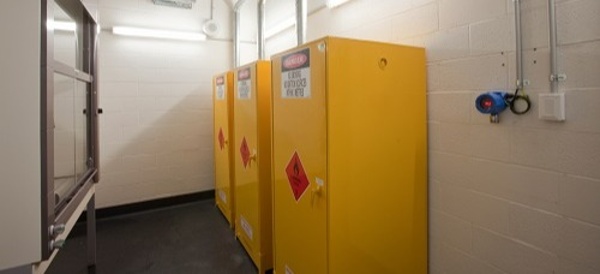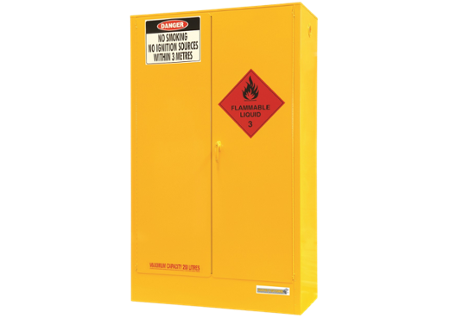A flammable liquids cabinet is a sophisticated hazard control measure that can reduce risk for your business. But it can’t protect your people, property and environment if it’s been installed, used or maintained in an unsafe way. Afterall, the dual skinned walls and the patented door closing system of a Storemasta flammable cabinet can’t minimise chemical risk if you’re overloading the shelves, installing the equipment near an ignition source – or loading it with the wrong chemical class.
To help you stay safe and maintain your investment, we’re detailing a range of housekeeping practices that you can include in your flammable liquids storage cabinet operations and training manual.
IMPORTANT: While operating procedures are essential for chemical controls, such as flammable liquids cabinets, they must be backed up by supervision and training. Make sure you train (and re-train) your team on how to properly use your flammable cabinet, so you can control risk in your operations.
Deliveries and Storage
Once you’ve installed your flammable liquid storage cabinet, take the time to train your workers and contractors to use it properly and follow strict housekeeping procedures.
Please include the following in your flammable cabinet housekeeping procedures:
- Put away chemical deliveries immediately — there is no point having a flammable liquids cabinet if chemicals are left sitting on the ground next to the cabinet.
- Streamline your chemical deliveries to avoid excess stocks.
- Never load a flammable liquids cabinet past its approved storage capacity (refer to the flammable cabinet label on the front of the equipment).
- Remove excess packaging (cardboard, polystyrene, plastic cartons), these materials are combustible and increase the fire hazard.
- Wipe down the exterior of containers and ensure that all lids are in place before the containers are put back in the cabinet.
- Stack containers and drums carefully so they don’t protrude and block the self-closing mechanism on the doors. Flammable liquids cabinets must not stack drums (60 L or more in capacity) more than 2 high.
- Don’t place any items in the spill compound.
- Don’t waste valuable shelf space on non-flammables — eg, tools, PPE and sundry items.
- Keep the top of the cabinet clear and don’t allow anyone to use it as an extra shelf for empty chemical drums, coffee cups, paperwork, PPE or other items.
- Clear the sump immediately after a leak or spill and don’t forget to wipe down the shelves. Dispose of spilled waste properly.
- Never place ignition sources inside or within 3 metres of the cabinet — eg, matches, lighting, electronics.
- Don’t use sticks, mops handles, or other items to prop open the doors on the cabinet. They are supposed to be kept closed.
- Don’t use the top of the flammable liquid storage cabinet as a decanting station.

Is the flammable cabinet location sufficiently placarded and lit to ensure staff are aware of the hazardous substances stored in that work area?
Flammable Cabinet Lighting and Signage
In Australia, you must store hazardous chemicals in well-lit areas that are clearly marked with appropriate warning placards and safety signs. It’s a requirement of the Australian Standards that all warning signs and regulatory markings must be completely visible whenever the cabinet doors are closed.
Please ensure that:
- Warning signs, placards and flammable cabinet labels are not covered in any way — eg, uniforms or fabric that draping down over the sides, flammable cabinet stickers, sheet metal leaning up against the cabinet, pallets or forklift vehicles left in front.
- Missing, damaged, scratched, defaced, or faded signs are replaced immediately.
- Lighting is safe and fully functional — eg, there is enough lighting to clearly read the signs and it is not discharging or creating sparks.
Like to learn more about flammable safety?
Flammable Cabinet Maintenance, Cleaning and Repair Work
Take care of the area surrounding your flammable liquid storage cabinet, this includes keeping it clean and tidy as well as restricting the activities you allow there.
Consider the following best practices, as a minimum:
- Don’t allow workers and contractors to carry out maintenance and repair work near the cabinet. You don’t want activities like welding, cutting, soldering and grinding that generate heat, sparks and flames.
- Never allow a person to climb inside the cabinet for any reason.
- Restrict vehicular access to the area unless you have crash bollards or other impact protection around the cabinet.
- Ensure cleaners, maintenance contractors, delivery drivers and other personnel don’t bring incompatible chemicals, electronic gadgets and other ignition sources into the area.
- Make sure there is always a clear space between the cabinet and the first aid kit, emergency shower and eyewash station.
- Keep the area in front of the cabinet free of obstructions (eg, parked forklifts, unloaded pallets) and minimise the amount of combustible materials kept in the vicinity of the cabinet.
Your flammable cabinet must provide the controls that it was originally designed to provide. Inspect for any signs of misuse, damage or non-compliant practices in or around the cabinet.
Maintaining Flammable Cabinets
All safety equipment in your workplace requires some kind of maintenance. We suggest carrying out regular integrity checks on your flammable liquids cabinet to ensure longevity, safety and compliance.
As a minimum, you should be:
- Inspecting the interior and exterior of the cabinet for signs of corrosion, spillage, dents and damage.
- Following up with workers or contractors who did not report incidents involving the cabinet eg, they knocked over the cabinet with a forklift and didn’t tell anyone.
- Inspecting drums and containers inside the cabinet for signs of deterioration and damage.
- Checking working parts and componentry — eg, are the doors closing automatically in sequence? is the spill sump liquid tight? is the shelving intact?
IMPORTANT: Is your flammable cabinet ready to be decommissioned? Reach out to our helpful Dangerous Goods Storage Consultants for help on choosing your next Class 3 cabinet.
Flammable Liquid Storage Safety Tips
Does your business need a housekeeping cabinet checklist? Or are you interested in keeping your equipment in top condition. You can reduce the risk of fire, flammable vapour emissions, spills and human harm by practicing good housekeeping practices for your safety cabinets. However, it’s sometimes difficult to know where to begin. That’s why we’ve created this convenience Chemical Cabinet Checklist that you can use as a basis for your safety cabinet inspections. This checklist offers general advice for inspecting and maintaining all types of safety cabinets, so you can further improve your compliance with regular inspections, housekeeping and maintenance. Get your copy for free today.
Joining the team as a Dangerous Goods Storage Consultant, Melissa Hampton became Storemasta's Marketing Manager in late 2021. With extensive knowledge and experience in chemical compliance, Melissa is responsible for leading the Marketing team and helping shape their marketing strategy. In her spare time, you can find Melissa hiking, swimming and enjoying the great outdoors in beautiful north-west Tasmania.

